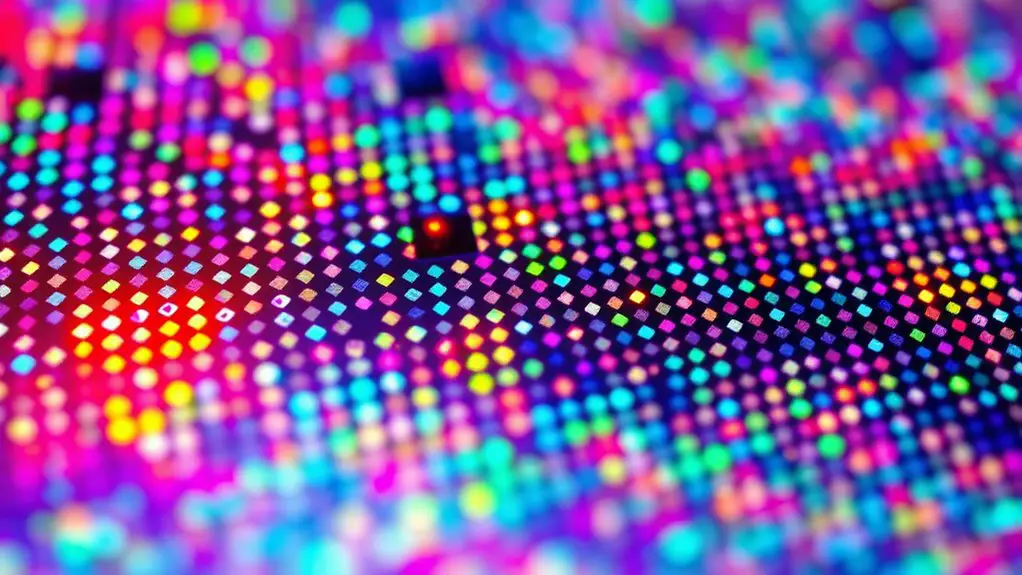The physics of light in display panels affects color accuracy, contrast, and visual experience. Light behaves as both a wave and particle, influencing how different display technologies absorb and emit light. LCDs, OLEDs, and QLEDs have varying absorption characteristics, impacting color rendering capabilities. Accurate color representation is essential for effective communication across devices. Innovations like quantum dots and flexible designs enhance performance. Understanding these principles will broaden your insight into future advancements in display technology.
The Basics of Light and Its Properties
Light, a fundamental aspect of our visual experience, is an electromagnetic wave that exhibits both particle and wave-like properties. This phenomenon, known as wave particle duality, allows you to perceive light in various forms. On the electromagnetic spectrum, light occupies a specific range, with visible light being just a tiny fraction of the whole. This spectrum extends from radio waves to gamma rays, highlighting the diverse interactions of different wavelengths. Understanding these properties empowers you to appreciate how light behaves under various conditions, affecting everything from color perception to energy transfer. By grasping the principles of light, you can navigate the intricate world of visual technologies and enhance your experience of the environments around you.
How Light Interacts With Different Display Technologies
As various display technologies evolve, understanding how they interact with light becomes essential for optimizing visual performance. Different technologies exhibit unique characteristics regarding light absorption, scattering, and color rendering, which directly influence display brightness.
| Display Technology | Light Absorption | Color Rendering |
|---|---|---|
| LCD | Moderate absorption | Good |
| OLED | Low absorption | Excellent |
| LED | Variable absorption | Good |
| QLED | Low to moderate absorption | Very good |
| MicroLED | Minimal absorption | Outstanding |
The Role of Color in Display Performance
While the technical specifications of display panels often focus on brightness and resolution, the role of color in display performance is equally crucial. Color perception directly impacts how viewers interpret images and videos, making accurate color representation essential for effective communication. You need to guarantee proper color calibration across devices to maintain consistency, especially in professional settings like graphic design or video editing. A well-calibrated display can reproduce a wider color gamut, enhancing depth and vibrancy, which greatly enhances the user experience. In contrast, poor color performance can lead to misleading visuals, undermining the intended message. Therefore, understanding color dynamics and their calibration plays a pivotal role in optimizing display performance, making sure that what you see aligns closely with reality.
Innovations in Display Technology: A Light-Driven Revolution
With advancements in technology reshaping display panels, the integration of innovative light-based techniques is driving a new era of visual experience. OLED advancements are revolutionizing how you perceive color and contrast, providing deeper blacks and enhanced brightness. These self-emissive displays offer greater flexibility in design, allowing for ultra-thin and curved screens that adapt to your viewing preferences. Meanwhile, quantum dot enhancements are elevating color accuracy and vibrancy, improving energy efficiency as well. This combination of OLED and quantum dot technologies not only enhances your visual engagement but also contributes to a more sustainable future in display technology. Together, they're redefining your interaction with screens, ensuring a more immersive and visually stunning experience tailored to your needs.
The Future of Light in Display Panels
The ongoing advancements in OLED and quantum dot technologies pave the way for an exciting future in display panels, where light plays an even more pivotal role. As you explore this domain, you'll find that quantum dots will enhance color accuracy and brightness, fundamentally altering your viewing experience. Furthermore, the integration of laser displays promises unprecedented contrast ratios and energy efficiency. These technologies will enable displays to become thinner, lighter, and more versatile, allowing for innovative applications across various platforms. As a result, you'll have access to a world where your screens can adapt to different lighting conditions seamlessly. Embracing these advancements will grant you the freedom to explore visual content like never before, bringing clarity and vibrancy to everyday interactions.
Frequently Asked Questions
How Does Ambient Light Affect Display Visibility?
Ambient light affects display visibility like a thousand suns blaring down! You'll need to adjust brightness settings to guarantee ideal ambient contrast, making your screen clearer and enhancing your viewing experience in varying lighting conditions.
What Are the Environmental Impacts of Display Panel Production?
The environmental impacts of display panel production include resource depletion and pollution. You should consider using sustainable materials and recycling methods to minimize these effects, promoting a more eco-friendly approach while ensuring efficient production and waste management.
How Do Display Settings Influence Eye Strain?
You might not realize it, but your display settings subtly sway your comfort. Adjusting brightness and color temperature can greatly reduce eye strain, creating a more harmonious viewing experience while allowing your eyes to breathe freely.
Can Light Pollution From Displays Affect Sleep Patterns?
Yes, light pollution from displays can disrupt your sleep patterns. Excessive blue light exposure, especially before bedtime, interferes with melatonin production, leading to sleep disruption and making it harder for you to fall asleep soundly.
What Materials Are Used in Anti-Glare Coatings?
Ever wondered what keeps glare at bay? Anti reflective technology uses a combination of specialized coatings and surface treatments, like silica or metallic oxides, to enhance visibility and reduce reflections on screens.

